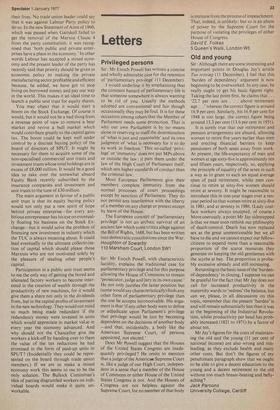Old and young
Sir : Although there are some interesting and important points in Douglas Jay's article Too retiring (II December), I feet that this 'burden of dependency' argument is now beginning to be overworked. In any case, he really ought to get his basic figures right. Taking the last point first, he claims that ... '22.7 per cent are . . . above retirement age ...' whereas the correct figure is around 16.9 per cent. Similarly, his 16.9 per cent for 1948 is too large, the correct figure being around 13.3 per cent (13.6 per cent in 1951).
It is surely true that our retirement and pension arrangements are absurd, allowing women to retire five years earlier than men and erecting financial barriers to keep pensioners of both sexes away from work. At present, the life-expectancy of men and women at age sixty-five is approximately ten and fifteen years, respectively, so, applying the principle of equality of the sexes in such a way as to grant to each an equal average span of paid retirement, whilst men continue to retire at sixty-five women should retire at seventy. It might be reasonable to introduce this in one-year stages over a tenyear period so that women retire at sixty-five in 1981, and at seventy in 1986, (Lady coalface workers always excepted, of course.) More onerously, anoint Mr Jay sidestepped is that we must soon rethink our philosophy of death-control. Death has now replaced sex as the great unmentionable but we all have to die and we cannot expect our fellowcitizens to expend more than a reasonable proportion of the scarce resources they generate on keeping the old gentleman with the scythe at bay. The proportion is probably excessive already and still increasing.
Returning to the basic issue of the 'burdenof-dependency' in closing, I suppose we can be grateful for the fact that Mr Jay does not call for increased productivity in the maternity wards to 'redress" the balance, but can we, please, in all discussions on this topic, remember that the present 'burden' is and will remain substantially less than it was at the beginning of the Industrial Revolution, whilst productivity per head has probably increased (1821 to 1971) by a factor of about ten.
Mr Jay's figures for the costs of maintaining the old and the young (11 per cent of national income) are also wrong and misleading, as they exclude health and many other costs. But don't the figures of my penultimate paragraph show that we ought to be able to give a decent education to the young and a decent retirement to the old without too much breast-beating and bellyaching?
Jack Parsons University College, Cardiff






















































 Previous page
Previous page